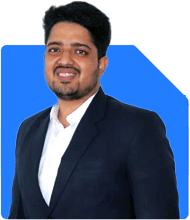40-Year-Old Aims for 10 Cr in 10 Years: Good ETF Plan or Time for a Change?
Ramalingam Kalirajan |10893 Answers |Ask -Follow
Mutual Funds, Financial Planning Expert - Answered on Sep 16, 2024
He has an MBA in finance from the University of Madras and is a certified financial planner.
He is the director and chief financial planner at Holistic Investment, a Chennai-based firm that offers financial planning and wealth management advice.... more

Sir, I am 40 years old and planning to invest my money in following smart beta ETF. Investment in Each ETF will be 10K/month and in Gold ETF will be 50 K/month making a total of 1.4 Lac/month 1)MIDSMALL 2) SMALLCAP 3) NV20IETF 4)ALPHA 5) MOM30IETF 6) ALPL30IETF 7)PHARMABEES 8)ICICB22 9)ALPHAETF 10)GOLDBEES. Also I have kept aside a corpus of Rs 50 lacs to invest in said ETF as and when there is a suitable correction in market in a phase wise manner. Kindly suggest if I should continue to invest as planned or make any changes in terms of number of ETF /investment amount. My goals is achieve a corpus of at least 10 Cr in 10 years.
Portfolio Diversification
Your current portfolio is highly ETF-centric, which includes allocations to mid-cap, small-cap, pharma, and gold ETFs, among others. While smart beta ETFs offer an innovative approach to investment, it's crucial to assess whether this level of concentration is ideal for your goal of corpus creation.
Overconcentration on ETFs: While ETFs offer cost efficiency and diversification, relying heavily on them could expose you to higher volatility, especially in small- and mid-cap spaces. Consider balancing it with actively managed funds, as they can add a layer of expertise, especially in unpredictable market conditions.
Gold Allocation: Investing Rs 50,000 per month in Gold ETFs, about 35% of your total monthly investment, is quite significant. Although gold acts as a hedge, it tends to perform well only in specific scenarios, such as during economic uncertainties. Maintaining a lower allocation to gold, around 10-15%, would reduce the risk of opportunity loss from other high-growth assets.
Smart Beta ETFs: Advantages and Limitations
You are already aware of the benefits of smart beta ETFs, but they also come with some limitations. Here’s an analysis:
Benefits of Smart Beta ETFs: These ETFs attempt to outperform traditional index funds by focusing on factors like momentum, value, and low volatility. They offer transparency and lower fees compared to actively managed funds.
Limitations: Smart beta ETFs can sometimes lag in changing market conditions. Unlike actively managed funds, they do not adjust quickly to market trends. This can be a limitation in times of market correction or when there's a downturn in a particular sector.
Since your plan focuses on ETFs, I would suggest supplementing this with some actively managed funds to make your portfolio more adaptable to changes in the market.
Disadvantages of Index Funds
Index funds, while popular for passive investing, have inherent drawbacks in certain contexts:
Limited Growth Potential: Index funds generally track the market. This can limit the potential for significant outperformance during high-growth phases. Over-reliance on them can cap your upside.
Less Flexibility: Unlike actively managed funds, index funds do not have the flexibility to react to market changes. This rigidity can work against you in a dynamic market, especially when pursuing long-term growth targets like yours.
Thus, while ETFs are cost-effective, introducing more actively managed funds could boost performance over time.
Corpus of Rs 50 Lakh for Market Corrections
Your approach of keeping Rs 50 lakh aside for investing during market corrections is prudent. Here are a few suggestions to optimise the deployment of this corpus:
Phased Investments: Avoid timing the market too aggressively. Consider deploying the Rs 50 lakh corpus through a Systematic Transfer Plan (STP) over 6-12 months, especially during volatile phases. This approach reduces the risk of investing all at once at a market peak.
Diversified Deployment: Distribute the Rs 50 lakh across equity and debt funds. This will allow for growth opportunities while ensuring some stability. High exposure to equity ETFs alone may not serve the purpose during downturns.
Opportunities Beyond ETFs: A part of this corpus can be allocated towards actively managed mutual funds with proven track records. Funds focusing on large-cap and multi-cap categories could help enhance stability during corrections.
Risk Analysis and Asset Allocation
Your current allocation leans heavily toward equities, with a substantial focus on mid-cap, small-cap, and sector-specific ETFs like pharma. While this has a high growth potential, it increases your portfolio’s risk profile. Here are some observations and recommendations:
Sector-Specific Risk: Allocating to sector-specific funds like pharma ETFs adds concentration risk. The performance of such sectors can be cyclical, and being too heavily invested in one sector may limit your ability to recover during downturns.
Volatility of Small and Mid-Cap Funds: Small-cap and mid-cap ETFs are known for their volatility. They can offer high returns but can also lead to significant drawdowns. Diversifying your exposure into some large-cap actively managed funds would be advisable.
Gold Exposure: While gold serves as a good hedge, an allocation of 35% is on the higher side. Reducing it to about 10-15% would allow you to allocate more to equity, where you can achieve better long-term returns.
The Importance of Actively Managed Funds
Better Flexibility and Expert Management: Actively managed funds offer professional expertise in stock selection and market timing, which can enhance returns, especially during volatile markets.
Dynamic Strategy: Unlike passive ETFs, actively managed funds can adapt quickly to market conditions. In a volatile or corrective market, this agility can help protect your portfolio while still allowing for significant growth.
Historical Outperformance: Many actively managed funds have outperformed passive strategies over long time periods, especially in the Indian market. These funds can provide higher returns, particularly in equity-heavy portfolios.
Recommendations for Asset Reallocation
To achieve your goal of Rs 10 crore in 10 years, you may need to rethink your allocation and mix it with more actively managed funds:
Lower Gold Allocation: Reduce your gold ETF contribution from Rs 50,000 to Rs 20,000 per month. This allows you to invest the remaining Rs 30,000 into growth-focused mutual funds.
Balance Sector Exposure: Consider reducing sector-specific ETFs like pharma. Reallocate part of it to more diversified funds, focusing on large- or flexi-cap categories.
Increase Actively Managed Exposure: Introduce actively managed large-cap or multi-cap mutual funds into your portfolio. These funds can provide more stability and still offer growth over the long term.
Maintain the Rs 50 Lakh Corpus for Corrections: Continue with your plan to deploy the Rs 50 lakh corpus in phases during market corrections. However, consider a more diversified allocation across equity and debt funds.
Final Insights
You have an ambitious goal of reaching Rs 10 crore in 10 years, and your dedication is evident. However, a more balanced portfolio, with exposure to both ETFs and actively managed funds, will help you navigate market volatility and maximise your returns.
Balanced Allocation: Reassess your allocation to sector-specific and small-cap ETFs, as they can be volatile.
Gold: Reduce your monthly gold allocation and direct more towards equities.
Phased Deployment: Continue with phased deployment of your Rs 50 lakh corpus during market corrections.
Active Funds: Introduce actively managed funds for better market adaptability and potentially higher long-term returns.
Best Regards,
K. Ramalingam, MBA, CFP,
Chief Financial Planner,
www.holisticinvestment.in
You may like to see similar questions and answers below
Nikunj Saraf | Answer |Ask -Follow
Mutual Funds Expert - Answered on Jun 26, 2023
Ramalingam Kalirajan |10893 Answers |Ask -Follow
Mutual Funds, Financial Planning Expert - Answered on Apr 04, 2024
Sanjeev Govila | Answer |Ask -Follow
Financial Planner - Answered on Mar 28, 2024
Ramalingam Kalirajan |10893 Answers |Ask -Follow
Mutual Funds, Financial Planning Expert - Answered on May 14, 2024
Ramalingam Kalirajan |10893 Answers |Ask -Follow
Mutual Funds, Financial Planning Expert - Answered on Dec 15, 2025
Ramalingam Kalirajan |10893 Answers |Ask -Follow
Mutual Funds, Financial Planning Expert - Answered on Dec 15, 2025
Radheshyam Zanwar |6746 Answers |Ask -Follow
MHT-CET, IIT-JEE, NEET-UG Expert - Answered on Dec 15, 2025
Ramalingam Kalirajan |10893 Answers |Ask -Follow
Mutual Funds, Financial Planning Expert - Answered on Dec 15, 2025
Ramalingam Kalirajan |10893 Answers |Ask -Follow
Mutual Funds, Financial Planning Expert - Answered on Dec 15, 2025
Ramalingam Kalirajan |10893 Answers |Ask -Follow
Mutual Funds, Financial Planning Expert - Answered on Dec 15, 2025
Samraat Jadhav |2508 Answers |Ask -Follow
Stock Market Expert - Answered on Dec 15, 2025
Ramalingam Kalirajan |10893 Answers |Ask -Follow
Mutual Funds, Financial Planning Expert - Answered on Dec 15, 2025
Reetika Sharma |425 Answers |Ask -Follow
Financial Planner, MF and Insurance Expert - Answered on Dec 15, 2025
Radheshyam Zanwar |6746 Answers |Ask -Follow
MHT-CET, IIT-JEE, NEET-UG Expert - Answered on Dec 15, 2025

























